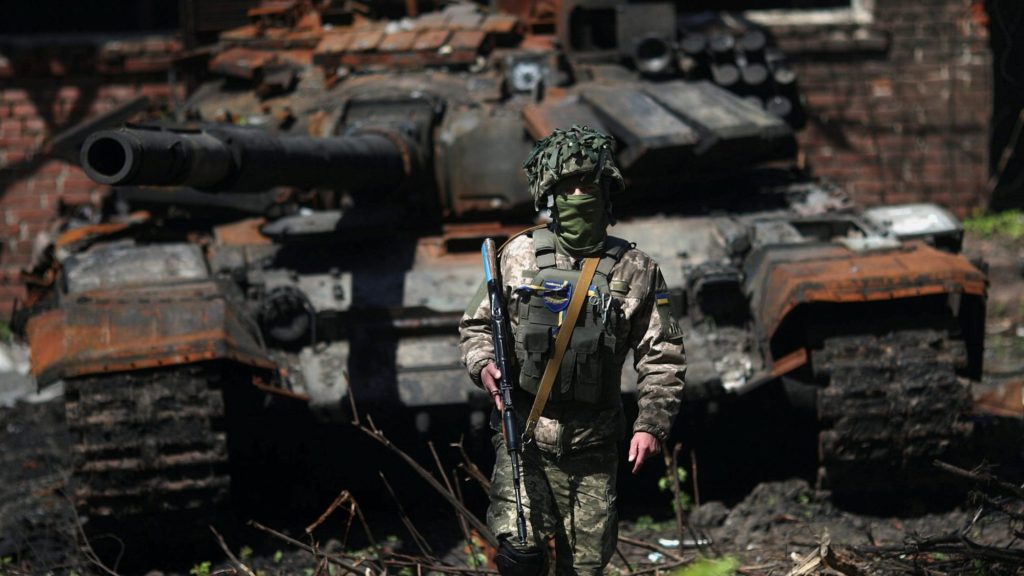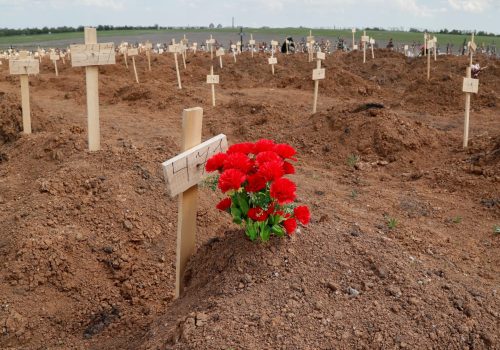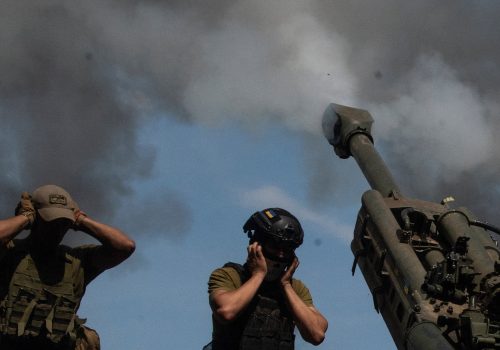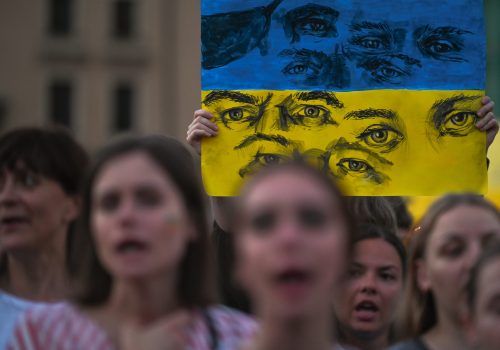In the six months since Russia invaded Ukraine, the Ukrainian military has conducted a stout and stirring defense, inflicting heavy casualties on Russian units and contesting every foot of ground. Against long odds, Ukraine managed to defend the capital, Kyiv, as well as its second largest city, Kharkiv. This has forced Russia to abandon its goal of a quick takeover of the country.
However, staving off defeat is not the same thing as victory. Russian forces today control about 20% of Ukrainian territory, including large tracts in the east and south. What does Ukraine need in order to win the war?
A first step must be to address the disparity in airpower. Success in modern, high-intensity warfare is almost impossible without at least parity in the air. Ukraine began the contest woefully behind the curve with perhaps 100 flyable jets compared to Russia’s more than 1,500. Where Russia has been able to conduct 100-200 sorties per day, the much smaller Ukrainian air force can manage around 10-20.
Accordingly, Ukraine has been generally unable to provide air support to its ground forces for fear of losing its small inventory of high-performance aircraft (mostly MIG-29 and SU-27 fighters and Su-24 and SU-25 ground attack aircraft). Instead, its approach has been to carefully husband its assets and use them only selectively.
On the other hand, Ukraine has been outstandingly successful in denying Russia air supremacy with extremely effective air defense and a strategy of “air denial.”
Though lacking the most advanced air defense systems such as the US Patriot or the Russian S-400, Ukraine’s use of older S-300 (high altitude), SA-11 (medium altitude) and SA-8 (short range) systems has been lethal to Russian airpower. The US has also provided small numbers of its NASAM short to medium-range air defense system, while Germany has promised to send decommissioned Gepard air defense vehicles, though ammunition shortages have delayed actual use.
Employed in concert with large numbers of US-supplied Stinger shoulder-fired missiles and using “shoot and scoot” tactics for survivability, Ukrainian air defense has downed dozens of Russian fixed and rotary-wing aircraft and largely sidelined Russian airpower. An adequate supply of air defense missiles for Ukrainian systems is essential here, and they must come from outside sources in quantity for Ukraine to prevail.
Ukraine has also used drones with devastating effect. The principal military platforms have been the Turkish Bayraktar TB2, which can deliver laser-guided bombs, and the US-supplied Phoenix Ghost drone as well as the Switchblade, a kamikaze drone with onboard explosives that can be flown into the target.
These military drones are supplemented with thousands of cheaper commercial drones used for artillery spotting and intelligence collection. Russian forces have adapted and the loss rate of Ukrainian drones is high, but low cost and ready availability mean that drones will continue to play an important role. When linked to nearby artillery units, drones enable quick target acquisition and precise fires, making the most of Ukraine’s limited artillery resources.
Ukrainian innovation and tactical agility have blunted much of Russia’s dominance in the air, but the ability to generate offensive airpower in the form of close air support and air interdiction will go far towards helping Ukraine prevail. Earlier in the war, Poland and other former Warsaw Pact nations suggested a transfer of Soviet-era jets to Ukraine, an offer blocked by US officials. If NATO is determined not to provide air cover, it is imperative that this block be removed and that partners be permitted to support the Ukrainian air force with platforms it can employ quickly to support air operations.
Backfilling these transfers with US fourth generation aircraft like the F-16 would also hasten the transition in Central Europe’s NATO member states from Soviet-era jets to more interoperable Western aircraft. Even 50 additional jets, with associated munitions and spare parts, could make a major difference in Ukraine. Without a boost in air support, a Ukrainian victory may still be possible if the strategy of air denial holds up, but it will come at higher costs to ground forces.
Stay updated
As the world watches the Russian invasion of Ukraine unfold, UkraineAlert delivers the best Atlantic Council expert insight and analysis on Ukraine twice a week directly to your inbox.
Just as important as air support is artillery, which comes in three forms: tubed, rocket, and missile. Ukraine began the war with substantial but outdated tubed artillery from the Soviet era, complicated by a dearth of ammunition. With some 2000 artillery pieces to Ukraine’s 500, Russian artillery is far more numerous, modern, and powerful, with a daily consumption of artillery rounds some 10 times greater than Ukraine’s.
As with air defense, Ukraine has used its limited artillery intelligently, quickly relocating after fire missions to avoid counter-battery fire and relying on drones for precision targeting. The addition of towed 155mm howitzers from the US and smaller numbers of 155mm self-propelled systems from Germany, France and other countries has strengthened Ukraine’s tubed artillery holdings considerably, but Russia’s advantage is still strong.
Here the US can help with M109A6 155mm self-propelled howitzers, recently replaced by the newer M109A7 model and now in storage in quantity. The M109A6 is an armored, tracked vehicle, more survivable against counter-battery fire, quicker to displace, and with smaller crews. It is accurate, lethal, and rugged, making it well-suited to Ukraine’s terrain and operational environment. Approximately 320 of these systems would give Ukraine four additional artillery brigades (one for each of its four regional headquarters), plus an additional battalion in general support for each of Ukraine’s 12 or so division equivalents, leaving some 10% for training and spares.
The real artillery game changer is the multiple launch rocket system in wheeled (M142 HIMARS) and tracked (M270 MLRS) variants. Both are long ranged, precise, mobile, and very destructive. Small numbers have been provided to date and have rendered excellent service. While Ukraine does field older rocket artillery systems like the BM-21 Grad and BM-30 Smerch, HIMARS and MLRS are far superior in range and precision.
As a matter of policy, the Biden administration has withheld longer ranged ATACMS ammunition that can strike targets up to 300 miles away. To level the playing field and transition to the offense with some hope of success, Ukraine probably needs some 50 or so HIMARS or MLRS systems, and it needs the ATACMS round. These capabilities will enable Ukrainian forces to strike high value targets like command posts, airfields, logistics hubs, air defense complexes, and ballistic missile launchers. Given the mismatch in airpower, long range rocket artillery has the potential to turn the tide and put Ukraine on a path towards ultimate success. Without it, victory will remain elusive.
Stronger airpower and more modern rocket artillery will greatly improve the odds, but Ukraine’s tank forces must also be strengthened. When the war began, Ukraine’s standard tank was the T-64B, an older and underpowered Soviet-era design lacking the most modern explosive reactive armor, thermal sights, and modern ammunition. While Ukraine has inflicted heavy losses on Russian armor (often using hand-held anti-tank weapons), its own tank force has been depleted and offensive breakthroughs with tank-heavy forces have not been possible.
Poland has committed to providing 240 PT-91 main battle tanks along with small numbers of Czech T-72s. To equip the Ukrainian army for offensive operations in 2023, the US should consider providing a similar number of M1A1 tanks from its large reserve stocks. Though not the very latest model, the M1A1 is more than a match for most Russian tanks and is available in large numbers.
Eurasia Center events

To assist Ukraine, NATO should consider establishing a NATO Training Mission-Ukraine (NTM-U) based in Poland and developed on a scale similar to the robust training support organizations seen in Iraq and Afghanistan. Led by a US three-star general with senior-level representation and staffing from the UK, France, Poland and Germany, NTM-U could provide the expertise, technical assistance, and “connective tissue” that is badly needed as Ukraine fights for its national existence. This organization can serve as the conduit back to the training bases and defense industries of contributing nations as well as the schoolhouse for Ukrainian commanders and staff officers.
Such full-blooded support, even without direct participation in the fighting, will undoubtedly draw Putin’s ire. Why should the US and its European partners risk a confrontation with a nuclear-armed Russia in this way? The clear answer is that a negotiated peace in Ukraine would be nothing of the sort. Any settlement that leaves Russia in control of occupied territory in exchange for a cessation of hostilities will reward Russia and encourage more aggression.
Western leaders can be sure that Russian success in Ukraine, even at high cost, will put NATO allies like the Baltic states squarely in Putin’s crosshairs. If anything, US and European reluctance to increase support for Ukraine will only reassure Putin that the West fears confrontation and will take pains to avoid it. This is not a recipe for deterring future aggression.
Nor should the West fear Russian rhetoric about the use of nuclear weapons. Distilled to its essence, this amounts to the threat of a nuclear exchange if Russia is not allowed to invade and occupy its neighbors. The nuclear deterrence regime that has been in place since the 1950s is surely strong enough to deter such wild adventurism.
Constant statements from Western leaders claiming “we cannot risk WWIII” only encourage Putin to believe that reckless threats about nuclear weapons are working. While a nuclear event cannot be ruled out entirely (Russia might stage a low-yield tactical nuclear detonation in a remote area, for example, to frighten and intimidate the West), the use of nuclear weapons in combat when the existence of the Russian state is not at risk is extremely unlikely.
The outcome of the conflict in Ukraine will have consequences far beyond Europe. China is watching carefully and will weigh the West’s commitment to its friends and partners carefully as it considers the military conquest of Taiwan, especially after the US and NATO’s chaotic withdrawal from Afghanistan. So will Iran and North Korea.
For the most part, Russian aggression in Georgia, Crimea, the Donbas, and more broadly in Ukraine has not been met with confidence and firm resolve. Instead, the Western response has consisted of sanctions, rhetoric, and a pronounced unwillingness to risk confrontation. We should not fool ourselves here. Much is at stake.
As the war grinds on, Ukraine has advantages it can leverage. These include an educated and highly motivated military and citizenry, a well-run and efficient railway system, a good understanding of modern technology, and an adaptive and innovative approach to the problems of modern, high-intensity warfare.
An intimate knowledge of the terrain and interior lines has enabled tactical success throughout the campaign. Ukrainian leadership, both civil and military, has on the whole been markedly superior to Russia’s. Above all, the Ukrainian soldier has proven to be tough, resourceful and determined, a fighter who “knows what he fights for and loves what he knows.”
Nevertheless, Ukraine is outmatched and must have stronger outside help to avoid dismemberment and continued occupation. The US and Europe do not need to introduce ground troops in order to ensure Ukraine’s success. Magnificent Ukrainian resistance has badly hurt the Russian military, which is almost totally committed in Ukraine. An opportunity now exists to end further Russian aggression in the European security space for a generation, and perhaps forever.
Ukraine can win the war but victory depends on Western support that goes well beyond the current level. We cannot ignore that Ukraine, too, has suffered painful losses in troops and materiel. Ukraine has been consistent and clear about its needs. Peace in Europe, and perhaps the world, depends on meeting them.
Richard D. Hooker Jr. is a nonresident senior fellow with the Atlantic Council. He previously served as Dean of the NATO Defense College and as Special Assistant to the US President and Senior Director for Europe and Russia with the National Security Council.
Further reading
The views expressed in UkraineAlert are solely those of the authors and do not necessarily reflect the views of the Atlantic Council, its staff, or its supporters.

The Eurasia Center’s mission is to enhance transatlantic cooperation in promoting stability, democratic values and prosperity in Eurasia, from Eastern Europe and Turkey in the West to the Caucasus, Russia and Central Asia in the East.
Follow us on social media
and support our work
Image: A Ukrainian soldier stands next to a destroyed Russian tank in Malaya Rohan village amid Russia's ongoing invasion of Ukraine, May 5, 2022. (REUTERS/Ricardo Moraes)




